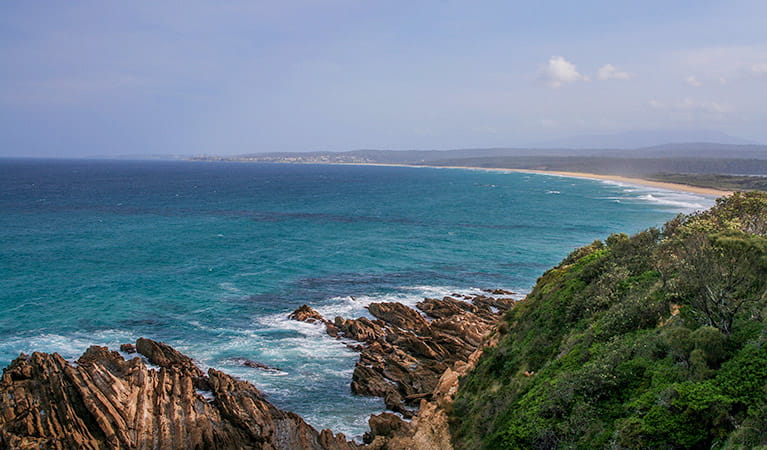Eurobodalla National Park
Overview
Great for a day trip or weekend getaway, Eurobodalla National Park, on the far south coast, offers fantastic camping, walking, surfing, whale watching and fishing.
Read more about Eurobodalla National Park
Eurobodalla National Park, on the far south coast of NSW, stretches from Moruya Head to Mystery Bay.
It’s an exceptional place to visit on a daytrip from one of the nearby coastal towns of Moruya, Narooma, Bodalla and Tuross Head, and offers a range of activities, so you’re bound to find something you enjoy.
Go surfing at 1080 Beach, or drop in your line at Brou Lake to try your luck at catching a fish or two. There are plenty of lookouts and headlands that offer amazing coastal views, as well as being great vantage spots for whale watching. You’re likely to see kangaroos and a range of birds around the park, plus the park’s lakes are popular for waterskiing and kayaking. If you’re keen to explore the park on foot, try the Bingi Dreaming track – a 14km walk along the coast south from Congo to Tuross Head.
You can camp by the beach at Congo campground, a popular spot for families or pitch your tent at Beachcomber Holiday Park; it's right by the beach and is a great spot to see kangaroos. Equally, if you’re camping in the park, you can always head out to explore quaint historic towns like Tilba and Mogo.
Local alerts
For the latest updates on fires, closures and other alerts in this area, see https://www.nationalparks.nsw.gov.au/visit-a-park/parks/eurobodalla-national-park/local-alerts
Map
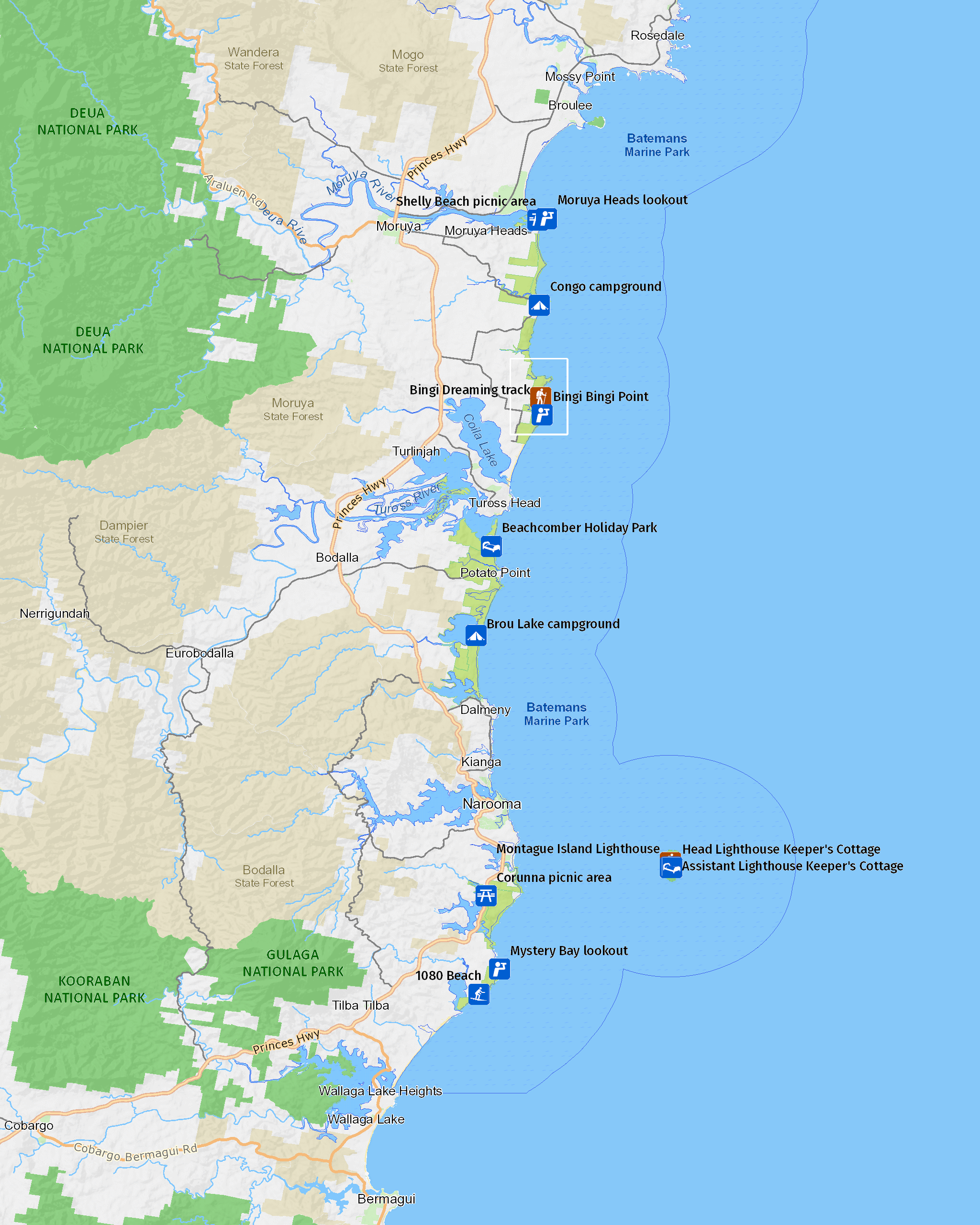
Map
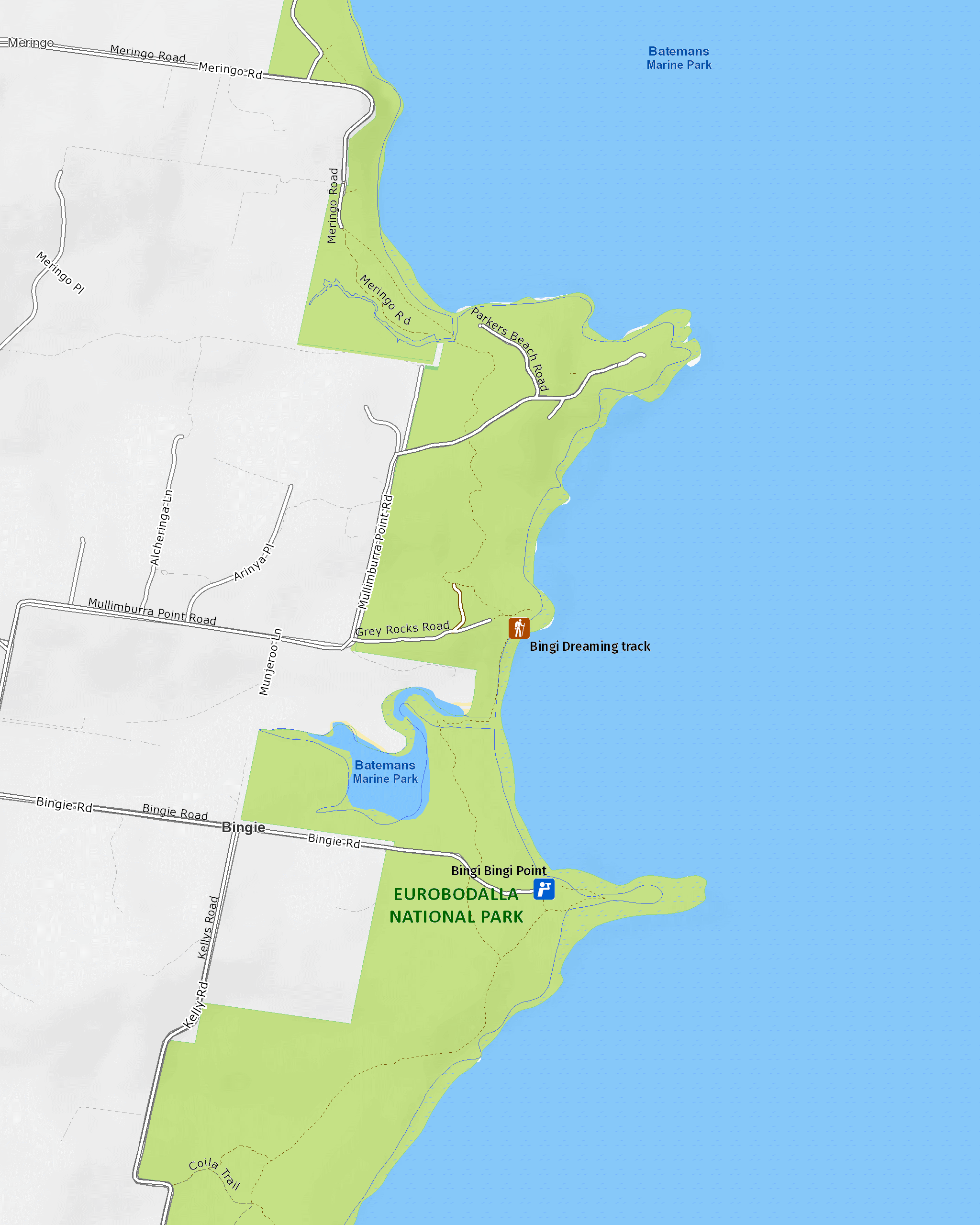
Map legend

Contact
- in the South Coast region
Eurobodalla National Park is always open but may have to close at times due to poor weather or fire danger.
-
-
Narooma office
02 4476 0800
Contact hours: Monday to Friday, 9am to 4pm. Office open by appointment only. Closed public holidays. - 10 Graham Street, Narooma NSW 2546
-
Email: npws.eurobodalla@environment.nsw.gov.au
-
Narooma office
Visitor info
All the practical information you need to know about Eurobodalla National Park.
Getting there and parking
Get driving directions
Eurobodalla National Park is accessible via a number of points along the Princes Highway – look for the signposts for particular areas.
- Take the Mystery Bay turnoff to access southern areas of the park
- Take Brou Lake Road to access the Brou Lake area of the park
- Take Potato Point Road to access the Potato Point area of the park
- Take South Head Road to access the area just south of Morurya
Parking Show more
- 1080 Beach See on map
- Beachcomber Holiday Park See on map
- Bingi Bingi Point See on map
- Corunna picnic area See on map
- Moruya Heads lookout See on map
- Mystery Bay lookout See on map
By bike
Check out the Bicycle information for NSW website for more information.
Best times to visit
There are lots of great things waiting for you in Eurobodalla National Park. Here are some of the highlights.
Autumn
Head out for a spot of fishing – either from the beach or lakeside, on a boat or from a kayak.
Spring
A lovely time of year to walk all or a short part the Bingi Dreaming track – coastal banksias and a range of other wildflowers will be on display.
Summer
The perfect time of year for a family camping holiday by the beach – try Congo campground near Moruya or Beachcomber Holiday Park near Bodalla.
Winter
Head to Mystery Bay for a picnic and spot of whale watching. be sure to take your binoculars for a close up view.
Weather, temperature and rainfall
Summer temperature
Average
18°C and 23°C
Winter temperature
Average
6°C and 17°C
Rainfall
Wettest month
March
Driest month
July
Facilities
Amenities
Toilets Show more
- 1080 Beach
- Beachcomber Holiday Park
- Brou Lake campground
- Congo campground
- Corunna picnic area
- Moruya Heads lookout
Picnic tables Show more
- 1080 Beach
- Beachcomber Holiday Park
- Brou Lake campground
- Corunna picnic area
- Moruya Heads lookout
- Mystery Bay lookout
Barbecue facilities
Boat ramp
Cafe/kiosk
Drinking water
Showers
Maps and downloads
Prohibited
Pets
Pets and domestic animals (other than certified assistance animals) are not permitted. Find out which regional parks allow dog walking and see the pets in parks policy for more information.
Smoking
NSW national parks are no smoking areas.
Nearby towns
Moruya (7 km)
Moruya is a historic dairy town on the Moruya River surrounded by dairy pastures and rugged national parks.
Narooma (12 km)
Narooma is Coastal town with superb beaches and abundant wildlife. Its set on the the foreshores wrapped around the Wagonga River estuary.
Tuross Head (25 km)
Tuross Head is a relaxed but invigorating town with wonderful leisure facilities. It's built on a coastal headland surrounded by broad waterways to the west and the vast Coila Lake to the north.
Learn more
Eurobodalla National Park is a special place. Here are just some of the reasons why:
Water abounds
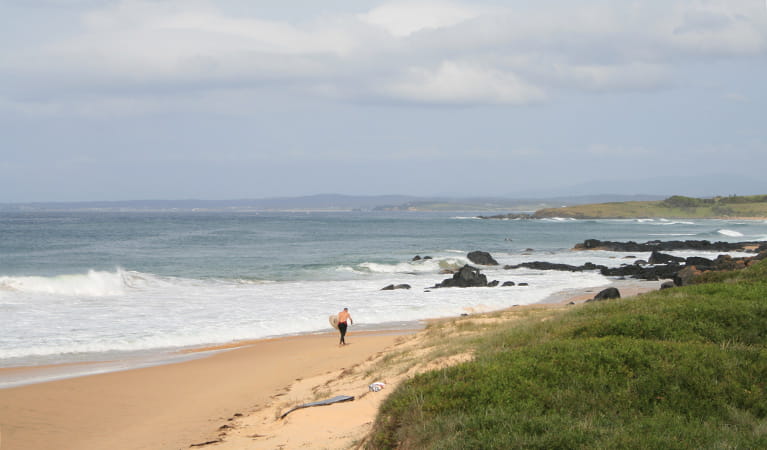
Eurobodalla National Park contains a range of aquatic environments, including lagoons, lakes, estuaries, sheltered and wild beaches that protect a wide variety of plants and animals. For visitors, these aquatic environments offer a huge range of water-based activities, like waterskiing and boating at Corunna Lake, fishing and swimming around Mullimburra Point, surfing at 1080 Beach and paddling on Brou Lake and around Lake Tuross. It's the perfect place to visit during the summer holidays.
Historic heritage
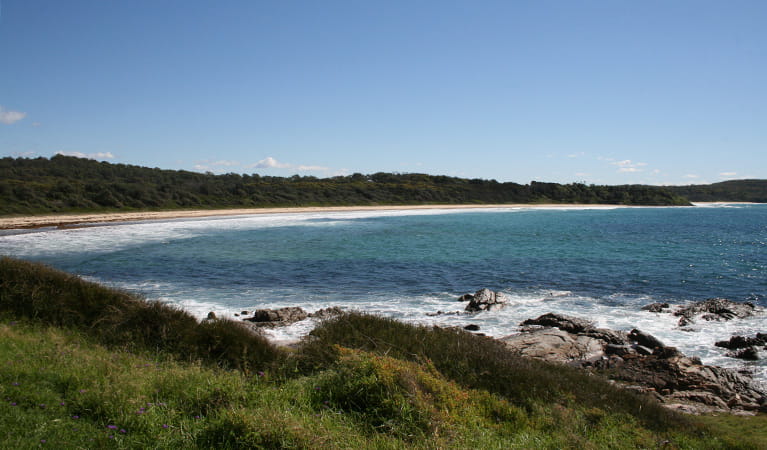
The period from the 1840's to the 1900's saw a rapid development of the area as a result of several often short-lived gold rushes, the growth of more intensive pastoral and agricultural land uses, and the expansion of timber getting activities. Many small towns grew up throughout the area, often acting as transport hubs and points of supply for surrounding districts. South Head at Moruya has many reminders of the important role shipping played, including several breakwaters and training walls that guided shipping through the river mouth, as well as the pilot's cottage and several smaller buildings situated on the headland.
Birds galore
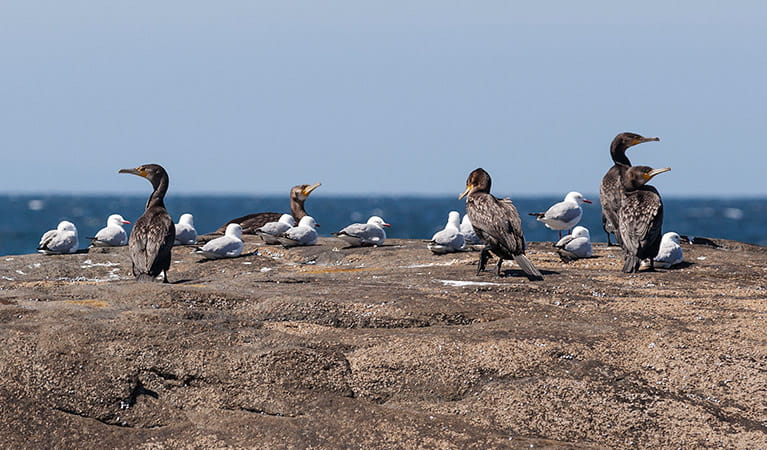
Eurobodalla National Park provides an important habitat for a wide variety of birds, with 131 bird species having been recorded in the park. Estuaries and headlands within the park are important over-wintering areas for migratory birds, including 17 species of waders. In the summer, you may be lucky enough to see little terns nesting on the ground on sand islands, sandspits and dunes. If you do, please take care not to disturb this precious bird. You may also catch a glimpse of a sooty owl roosting in eucalypt forests in deep moist gullies, or the hooded plover which was only recently recorded in the park with potential threats similar to those of the little tern.
- Bingi Dreaming track Head out for a day walk on the Bingi Dreaming track, a coastal walk that traces the ancient Song Lines of the Yuin Aboriginal people. Enjoy stunning views as you walk.
Aboriginal cultural heritage
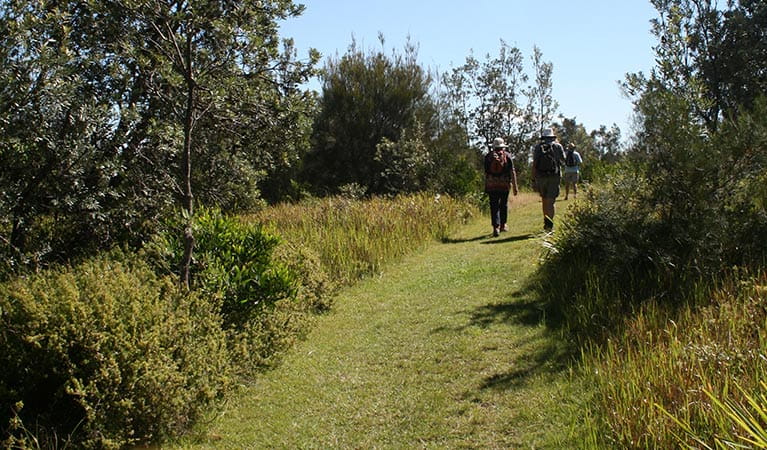
Eurobodalla National Park is the traditional Country of the Yuin People. The park's landscape provided a rich source of food, shelter, medicines and weapons and continues to be an important place for Aboriginal people today. Walk the Bingi Dreaming track to follow the footsteps of the Brinja-Yuin People. Dreaming tracks traditionally linked the places visited by local Aboriginal people, then extended to connect other places utilised by neighbouring clans so that all Aboriginal people in Australia were connected by these unique highways.
- Aboriginal culture tours at Eurobodalla Follow Aboriginal Dreaming tracks in Eurobodalla National Park on a guided tour with Minga Aboriginal Cultural Services. Take part in cultural activities and share in the local knowledge of the Yuin People.
- Bingi Dreaming track Head out for a day walk on the Bingi Dreaming track, a coastal walk that traces the ancient Song Lines of the Yuin Aboriginal people. Enjoy stunning views as you walk.
- Guided Aboriginal culture walk with a Yuin Elder Trace the footsteps of the Yuin People along Bingi Dreaming track in Eurobodalla National Park with Southbound Escapes. Hear Dreamtime stories and learn about Aboriginal culture on this 2-hour walking tour.
Plants and animals protected in this park
Animals
-

White-bellied sea eagle (Haliaeetus leucogaster)
White-bellied sea eagles can be easily identified by their white tail and dark grey wings. These raptors are often spotted cruising the coastal breezes throughout Australia, and make for some scenic bird watching. Powerful Australian birds of prey, they are known to mate for life, and return each year to the same nest to breed.
-
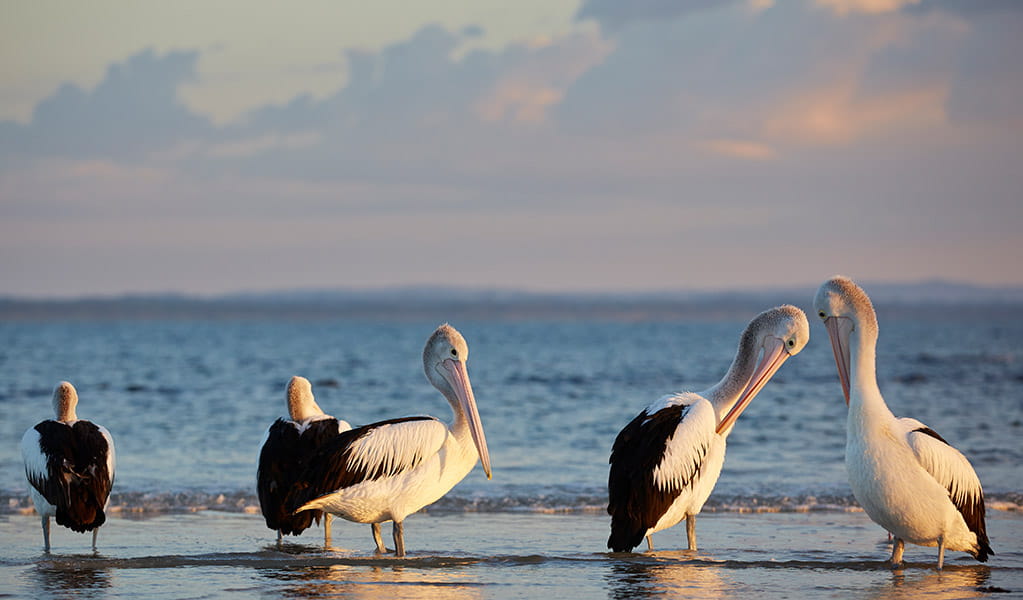
Australian pelican (Pelecanus conspicillatus)
The curious pelican is Australia’s largest flying bird and has the longest bill of any bird in the world. These Australian birds are found throughout Australian waterways and the pelican uses its throat pouch to trawl for fish. Pelicans breed all year round, congregating in large colonies on secluded beaches and islands.
-
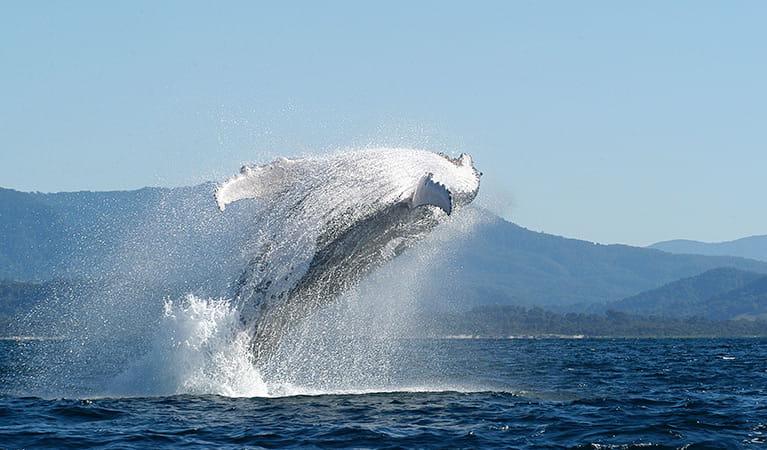
Humpback whale (Megaptera novaeangliae)
The humpback whale has the longest migratory path of any mammal, travelling over 5000km from its summer feeding grounds in Antarctica to its breeding grounds in the subtropics. Its playful antics, such as body-rolling, breaching and pectoral slapping, are a spectacular sight for whale watchers in NSW national parks.
-
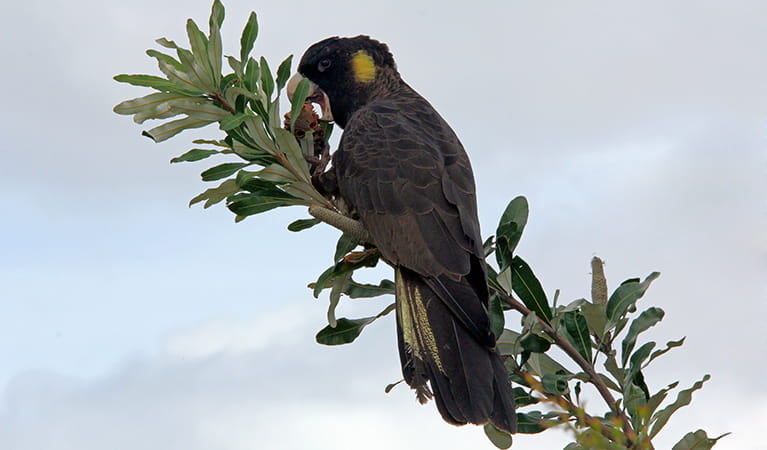
Yellow-tailed black cockatoo (Calyptorhynchus funereus)
The yellow-tailed black cockatoo is one of the largest species of parrot. With dusty-black plumage, they have a yellow tail and cheek patch. They’re easily spotted while bird watching, as they feed on seeds in native forests and pine plantations.
-
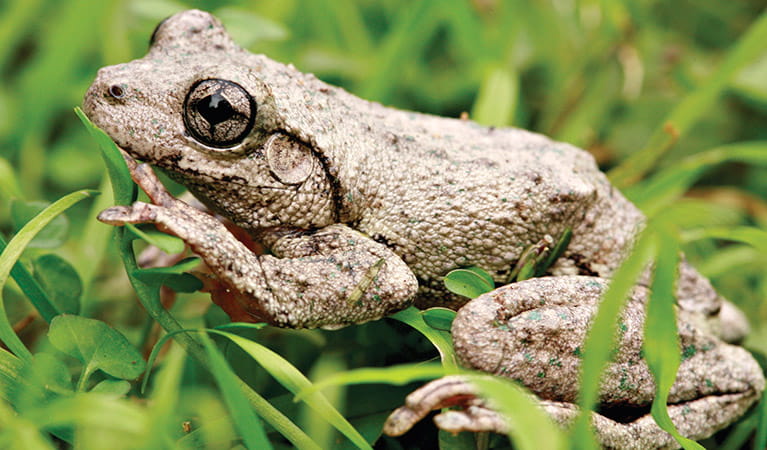
Peron's tree frog (Litoria peroni)
Peron’s tree frog is found right across NSW. These tree-climbing and ground-dwelling Australian animals can quickly change colour, ranging from pale green-grey by day, to a reddish brown with emerald green flecks at night. The male frog has a drill-like call, which has been described as a 'maniacal cackle’.
Environments in this park
Education resources (1)
What we're doing
Eurobodalla National Park has management strategies in place to protect and conserve the values of this park. Visit the OEH website for detailed park and fire management documents. Here is just some of the work we’re doing to conserve these values:
Understanding landscapes and geology
Eurobodalla National Park is dedicated to the maintenance of its landscapes and scenery, and ensures this in conjunction with land and native vegetation conservation. NPWS programs are in operation in this park, designed to protect park assets and ensure the character of the landscape is maintained, along with the park’s coveted coastal views.
Preserving biodiversity
Eurobodalla National Park upholds its biodiversity by protecting its threatened, vulnerable and endangered species and working to recover key populations. Conservation activities are habitually carried out in this park and may include monitoring, research into the distribution, abundance and habitat requirements of those populations, as well as bush regeneration, pest management strategies and other rehabilitative measures.
Managing weeds, pest animals and other threats
Pests and weeds have a significant impact to the ecosystems within Eurobodalla National Park. Risk assessments for new and emerging weeds are carried out as an ongoing initiative within the park. Pest management of wildlife like foxes, and weeds such as sea spurge, is an important part of the work NPWS does to protect the integrity of biodiversity which exists within Eurobodalla National Park.
Historic heritage in our parks and reserves
Eurobodalla National Park boasts a strong goldrush and shipping history and NPWS celebrates this heritage. Development is minimised in this park to uphold its heritage values. Management and conservation programs are in operation and may include the addition or improvement of interpretive signage for visitor education, research into the historic significance of key sites and subsequent actions to preserve them.
Developing visitor facilities and experiences
The facilities and infrastructure in Eurobodalla National Park are continually maintained and upgraded to ensure an optimal visitor experience. NPWS regularly reviews recreational opportunities in this park, identifying areas for improvement and reviewing and assessing any human impact on park assets.
Conserving our Aboriginal culture
Where opportunities exist, NPWS encourages shared management of Eurobodalla National Park with members of local Aboriginal communities. NPWS and the Aboriginal community work together to monitor and conserve Aboriginal sites within the park and to mitigate any adverse impacts. Interpretive signage around key cultural sites is maintained and updated regularly. NPWS also liaises with Aboriginal representatives on park developments wherever possible.
Managing fire
NSW is one of the most bushfire prone areas in the world as a result of our climate, weather systems, vegetation and the rugged terrain. NPWS is committed to maintaining natural and cultural heritage values and minimising the likelihood and impact of bushfires via a strategic program of fire research, fire planning, hazard reduction, highly trained rapid response firefighting crews and community alerts.

